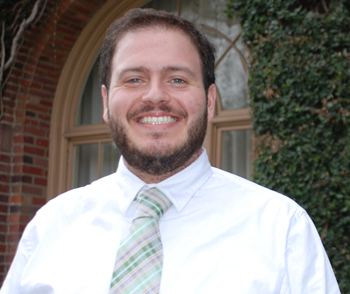
Lorry Black
By the time Lorry Black finishes his dissertation, the music of the Holocaust may very well be brought back to life.
Black is finishing his first semester as a doctoral student in sacred music at the USC Thornton School of Music. He was one of USC Shoah Foundation’s summer 2013 research fellows, conducting research in the Visual History Archive for his dissertation about the music of French concentration camps during the Holocaust.
Because Black’s background is in music performance, the fellowship was his first foray into academic research. He said USC Shoah Foundation’s associate director of research, Dan Leshem, and curator of the Visual History Archive, Crispin Brooks, helped him tackle the often overwhelming number of testimonies in the VHA.
“The breadth of the archive is insane,” Black said. “At first I was searching for my main keywords and getting segments here and there. But Crispin said, ‘Watch the entire testimony and see what you get from it.’”
Black estimates that he watched about 75 full testimonies and found 12 to 15 that he’ll continue to use in his research. Though it seems like a small number, the wealth of information contained in each testimony “has opened up floodgates,” he said.
While his dissertation is still in its earliest stage and the specific focus will likely change over the next three years, Black has delved mainly into the cultural and artistic activities that took place in four to five transit camps in France. These camps were influenced by an American named Tracy Strong, who worked with the European Student Relief Fund to establish special barracks and safe homes where students could avoid deportation to concentration camps. In all, Strong saved 79 students.
Through the testimonies in the Visual History Archive, Black has also learned of many artists and musicians who spent time in concentration and transit camps. Some of these artists went on to great careers in Europe and the United States after the war.
Some of the most memorable testimonies he watched don’t mention music at all, Black said. One woman describes the beautiful sunsets she watched from behind the wire of a concentration camp, and another man describes learning how to swim at a camp on the banks of the Mediterranean.
Black recalls another survivor who describes a camp as a “university,” because of its huge population of highly educated people, from lawyers and doctors to rabbis.
“He just loved the conversations. He loved sitting around with these people and talking,” Black said. “He said while it was miserable being locked up in a camp he wouldn’t have traded those moments for anything because it made him who he was.”
Even though his fellowship is over, Black will continue to use the Visual History Archive throughout his research. He also hopes to conduct a concert of music composed in concentration camps and transit camps at the conclusion of his dissertation.
What he’ll take away most from his time at USC Shoah Foundation is his collaboration with its staff, interns and other researchers, Black said.
“That time I spent with them will stick with me forever. It was invaluable. It was really nice to be around a group of people who are as passionate about the subject as you are,” Black said. “It makes you want to work and that’s why we’re all here: to contribute. The research is not for me, it’s for everyone else who will get to read it at some point.”